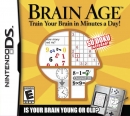Mr Puggsly said:
Right, now you're getting into studies pushing BS. The articficial sweetener companies are dealing with that even though some of them have been around for a long time. The epilepsy thing is different, that's a genuine problem even if it affects a small number of the population. The warnings are to protect them from getting sued and games are likely designed to not trigger that. Games certainly had more flickering in the 90s. These warnings sometimes just get people concerened about things with no evidence of being real. |
I think that through all this it is the bolded statement where you and I differ.
Take a look at this: https://www.nintendo.com/consumer/downloads/SPR_healthsafety_eng.pdf
I think we both agree that the warnings are there to protect the company against lawsuit. I think we also both agree that the warnings are there because of risks the consumers need to be aware of.
But they are also there to allow consumers to take their own decisions on how to protect themselves.
Some of the warnings there are based on known and tested fact (battery leakages, wireless interfering with pacemakers, photosensitive epilepsy etc). I presume this is what you mean by 'evidence of being real'.
Others are based on expert advice only; predictions that are yet to have confirmed links reported (e.g. kids' vision under the age of 6). I presume this is what you mean by 'no evidence of being real'.
Going back to the examples in our discussion, most people who smoked in the early 20th century were blissfully unaware of the link to lung cancer because to them, there was 'no evidence of being real'. When the scientific studies linking the two were published, the whole world changed its attitude to smoking, and now there are warnings everywhere.
So, if a game or console carries a caution that so far has 'no evidence of being real', I still want to know about it. Like the debunked MMR/autism example, it may well be proved unfounded in time. But equally, like the smoking/lung cancer example, future scientific research may change that warning about damaging young kids developing vision from having 'no evidence of being real' to being scarily real. That's why I want to be informed so I can make my own decision in the meantime.
Long story short - yes, there's some BS scaremongering out there, but theoretical risk should be treated as seriously as proven risk. I do believe all risks should be communicated to consumers, whatever their type.





















